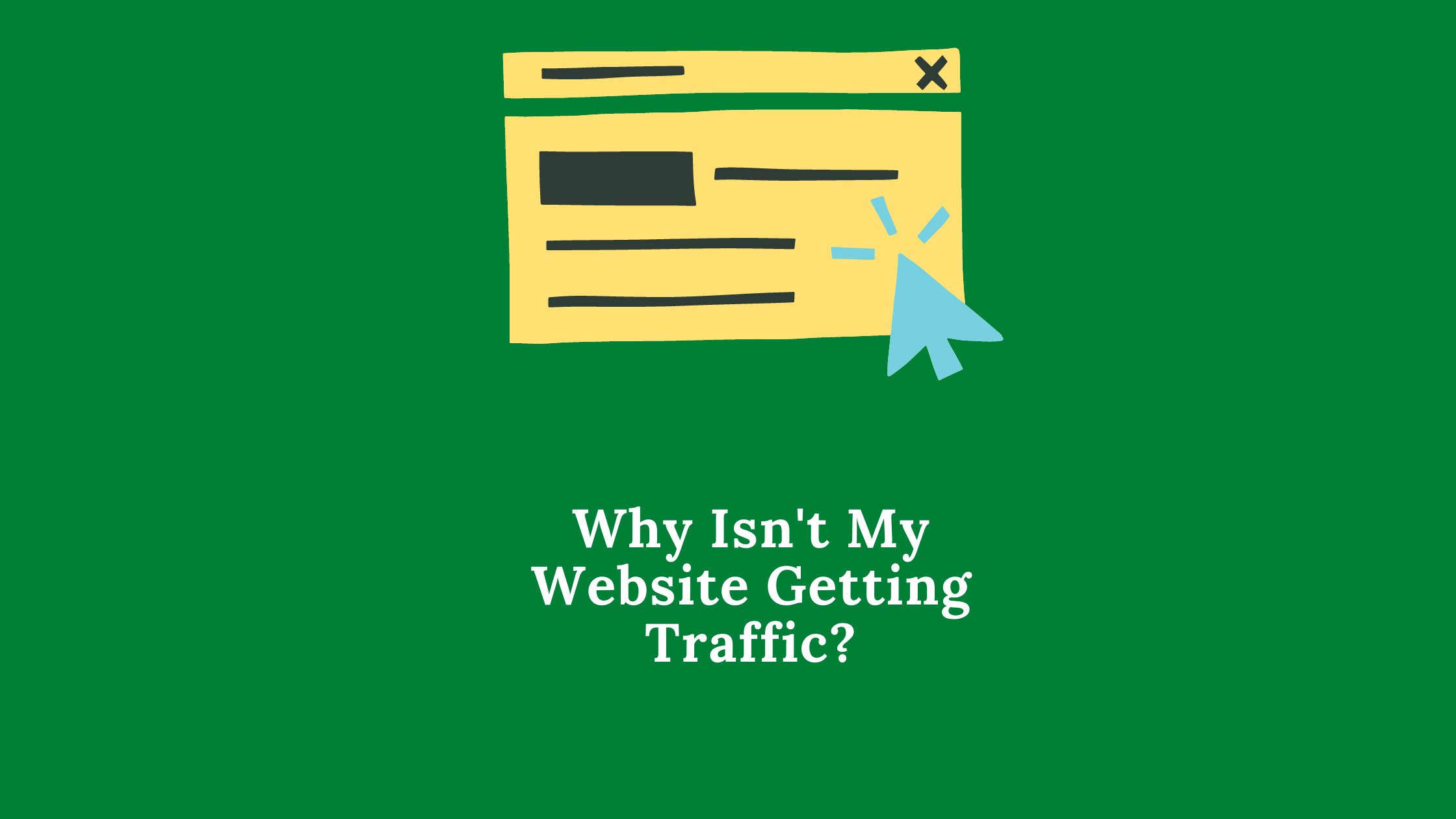If you’re like most business owners, you put a lot of time and effort into creating your website. You want it to be a successful tool for growing your business, but sometimes it seems like that’s not happening.
You may be wondering why isn’t my website getting traffic? There are many reasons why this could be the case, and we’ll cover five of the most common ones in this article.
We’ll also provide solutions so that you can start generating more traffic for your website!

Reasons You’re Not Getting Any Website Traffic
There are many reasons why your website may not be getting traffic. Here are five of the most common ones:
1. Your website is not optimized for search engines
One of the most important things you can do to increase your website traffic is optimize it for search engines.
Make sure your site is keyword-rich, and use those keywords throughout your website, including in the title, meta description, and body text.
You can also use tools like SEMrush to help you determine which keywords are most relevant to your business.
2. Your target keywords are too competitive for you to rank
There’s no point in writing content for a keyword that has too much competition. If you aren’t getting any traffic from your website, it could be because of this reason your website is not getting any traffic. Why isn’t my website getting traffic?
The solution to this problem is simple. Target low competition keywords that have high search volume.
You can use the Google Keyword Planner tool or Ahrefs’ Keywords Explorer tool, which will help find the right keywords for your niche and business model. Some of the tools are free!
3. Your website Is not mobile-friendly
If your website is not mobile-friendly, you’re likely losing out on a lot of traffic. In 2020, more than half of all Internet traffic came from mobile devices.
Therefore, if your site isn’t optimized for those devices, you’re missing out. Make sure your website is responsive so that it looks good and functions properly on all types of mobile devices.
4. You have no social media presence
Social media is another important factor when it comes to increasing website traffic. If you have no social media presence, you’re missing out on a huge opportunity to drive traffic from those channels.
It’s important that your website has social sharing buttons for all major networks so people can share your content with their friends and followers easily, but don’t forget about posting regularly too!
5. You don’t have an SEO plan in place
If you want to increase the amount of traffic coming into your site, it’s crucial that you have an SEO plan in place.
This means not only optimizing each page of your website for search engines like Google, Bing, or Yahoo but also making sure they are well-written and provide valuable information to readers who visit them.
Here are some ways you can improve upon these factors:
- Make sure there aren’t any broken links on any pages of your website.
- Make sure there aren’t any spelling mistakes or grammatical errors that could potentially confuse visitors who come across them while browsing through your site.
- Write unique content for each page so readers know they’re reading something new when they visit it, rather than the same old information (which could result in them leaving quickly).
6. Your website is slow to load
If your website takes too long to load, visitors will quickly lose interest and move on to another site.
Make sure you’re using a good hosting company with fast loading times, and also optimize your images so they don’t slow down the page.
7. Write for human beings, not search engines
When you’re writing for your website, always keep in mind that you are writing for human beings, not search engines.
This means providing valuable information and insights that people will want to read, rather than just stuffing your site with keywords in the hopes of ranking higher.
When you focus on creating quality content that people actually want to read, the traffic will come!
8. Your content is not good enough

If you are trying to increase the amount of traffic coming into your site, but it’s not working out well enough or as expected then maybe there is one thing you can do about this. Write better content.
You need to make sure that what you’re putting on your web pages and blog posts has been tailored specifically for humans who may be interested in reading them – otherwise they’ll just leave without ever visiting again.
This means providing valuable information and insights that people will want to read, rather than stuffing keywords into every paragraph hoping Google will rank higher (which doesn’t work).
If readers aren’t impressed with what they see when they come across one of these articles then chances are good they won’t come back either.
So make sure each piece is well-written, engaging enough to keep people reading until the end.
9. Does your website have enough content?
If you want to increase the amount of traffic coming into your site. It’s crucial that there is enough content on each page for people who may be interested in reading through them. Why? Because if there isn’t anything interesting or useful for them at all.
Chances are good they won’t even bother clicking around and looking elsewhere. This means less time spent browsing overall.
This can lead to higher bounce rates (when someone leaves without taking any action). It will also lead to lower conversion rates from visitors who are not finding what they need quickly due to not having much information available about a topic.
To avoid this problem try adding more posts with different topics related to the niche. This will enable readers to have plenty of options when searching your website for their desired keyword.
You can also add more images, infographics, or videos to help break up the text and keep people’s attention focused on your site.
10. Are you targeting the right audience?
Make sure you know exactly who your target audience is and what kind of content they might like to see on your site. This way you can tailor each post specifically for them (instead of just writing about anything). For example, if someone has been looking at buying a car then don’t write an article about how much money it costs.
But rather talk from their perspective by discussing things like mileage/fuel efficiency or safety features that matter most when choosing between models.
If readers aren’t impressed with what they see when they come across one of your articles then chances are good they won’t come back either. So make sure each piece is well-written, engaging enough to keep people reading until the end.
11. Why do you want more traffic anyway?
This is a question you need to ask yourself before anything else. Why do you want more traffic coming into your website? Is it because you’re looking for more leads or sales?
Or maybe you just want to increase brand awareness and get people talking about your company? Whatever the reason may be, make sure that it’s something that can realistically be achieved with the amount of effort you’re putting in (and make sure this is reflected in your content as well).
Otherwise, you could be wasting a lot of time and energy trying to achieve something that might not even be possible in the first place.
Meaning all those hours spent blogging or tweeting away will have been for nothing. So take a step back and figure out what it is exactly you want to achieve, and then make a plan on how you can go about it.
12. Do you have the right tools?
To increase traffic coming into your website. You’ll need to have some kind of analytics tool that helps measure how many visitors are interacting with each page on their visit (and what they’re doing while there).
Google Analytics is one example but there are plenty more out there like Mint or Mixpanel. If these aren’t available at an affordable price point. Then consider using a free alternative such as Matomo for tracking data about visitors and their behavior during visits. So you can optimize content accordingly.
Without this data, you’ll be flying blind and won’t know what’s working or not. Meaning you could easily be wasting time and energy on content that no one is even seeing.
So make sure to set up some kind of analytics tracking as soon as possible if you want to increase traffic.
13. Is the web content outdated?
One reason why your website might not be getting the traffic you want could be because the content is outdated. This can mean anything from having a design that’s no longer in style to blog posts that are several months (or even years) old.
If readers come across information like this then they’ll likely just leave and find another website that has more current and relevant data to share.
To avoid this, make sure to regularly update your site with new and original content so people always have a reason to keep coming back.
You can also use tools like Google Trends or BuzzSumo to help you see which topics are currently popular so you can write about those instead of sticking with older topics that have already been covered elsewhere on the web.
14. Are there any authoritative backlinks?

One of the best ways to increase traffic coming into your website is by getting links from other websites that are considered to be authoritative. This could mean anything from being listed on high-profile directories like BOTW or having links from well-respected publications (like The New York Times, for example).
The more quality links you can get pointing back to your site, the better it will rank in search engine results pages (SERPs). This will result in people finding your website.
So make sure to put some effort into building relationships with other bloggers, journalists, and webmasters. This will help increase the number of authoritative links pointing back to your site.
15. Is the website design user-friendly?
Another reason why a website might not be getting the traffic it wants is that the design isn’t user-friendly. This could mean anything from having a complicated navigation menu to using too many fonts and colors on each page.
If readers can’t easily find what they’re looking for or if the website looks too cluttered. Then they’ll likely just leave and never come back.
To avoid this, make sure to test your website’s design on different browsers and devices (like smartphones and tablets) to see how it looks and whether everything is easy to find and use.
You can also use tools like Google’s PageSpeed Insights to get feedback about ways you can improve the user experience of your website.
16. You’re not promoting your website enough
The last reason why your website might not be getting the traffic you want could be because you’re not promoting it enough. This could mean anything from posting on social media sites like Facebook or Twitter to sending out newsletters via email marketing services such as MailChimp.
If people don’t know about your website then they can’t visit it. So make sure to find ways of letting them know what’s available there and how they can benefit by checking it out.
You should also think about using tools like Google AdWords which will display advertisements based upon relevant keywords entered into search engines.
17. Your headlines aren’t clickable
One of the easiest ways to get people to click on your website links is by using headlines that are both catchy and relevant. This means thinking about what keywords or phrases people might enter into a search engine when they’re looking for information related to what you write about on your site.
For example, if you have a blog post about how to make a cake then you could use a headline like “How To Make A Perfect Cake – Every Time”. This would be more likely to attract attention than something like “My Blog Post”.
You can also use tools like CoSchedule’s Headline Analyzer to help you come up with better headlines that will grab attention and encourage readers to click through to your website.
Conclusion: Why isn’t my website getting traffic?
There are a number of different reasons why a website might not be getting the traffic it wants. By using the tips in this article. You can hopefully identify and fix any issues that might be preventing people from finding your site.
If you still have trouble getting people to visit your website. Then consider hiring a professional SEO company or individual to help you with this process. You can find affordable SEO services on Fiverr.
FAQ: Why isn’t my website getting traffic?
Q. How do I get traffic to my website?
A. There are many ways to get traffic. These include Search Engine Optimization (SEO), Social Media Marketing, Pay Per Click Advertising, Email Marketing and more.
Q. How long until my website gets traffic?
A. It usually takes about three months for a website to start getting traffic. It depends on how much work you put into it, though.
Q. Why isn’t my website getting traffic?
A. There can be many reasons, but some of the most common are: Website design, not user-friendly; you’re not promoting your website enough; headlines that aren’t clickable; and your website isn’t optimized for search engines.
Q. How can I improve my website’s traffic?
A. There are many ways to improve your website’s traffic. These include SEO, Social Media Marketing, Pay Per Click Advertising, Email Marketing, and more. You can also use tools like SEMrush and CoSchedule’s Headline Analyzer to help you achieve better results.




